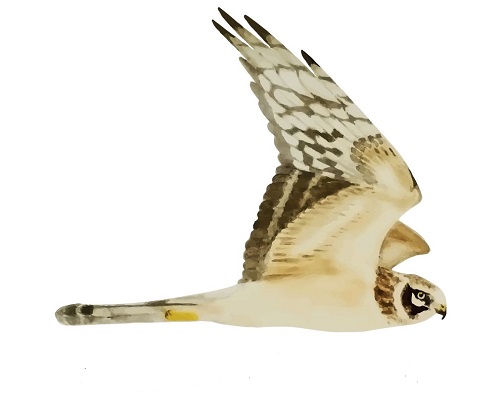Her på Skagen Fuglestations blog bringes korte nyheder i dagbogsformat om hændelser på fuglestationen.
Big Expectations
The weather forecast for today left us to expect a possible fallout of birds that were migrating west along the Atlantic coast. However, it seems that the front passing was probably bigger than expected and birds did not really move last night at all. Also, it was rather more windy than expected this morning. So the ringing team was a little disappointed, not because it was a bad day as such but because it was just not what we expected.
Even before we got to ring any birds we got distracted by three bitterns (rørdrum) flying very close to us which Fanny got this beautiful picture of.
The ringing was still interesting too, however, because not only have the willow warblers (løvsanger) passed for the biggest part, as already expected and we only caught very few today, but because we had several nice recaptures too. Among the birds caught today was a pretty male bullfinch (dompap) that has been ringed here in 2017.
Another bird we controlled today was a reed warbler (rørsanger) that was ringed at this same location in July 2017. It was ringed as an adult, so after this breeding season it is at least 4 years old. If you assume an average migration distance of around 6400 km from a breeding territory in southern Sweden via Spain to Ghana this means that this 12-gram bird has already migrated a total of more than 50,000 km!
At home we heard back from one of the birds we recovered with an English ring the other day, which is always nice: it was the male blackcap (munk) and it was ringed in Gibraltar in November 2018. Blackcaps are known to winter either in Britain or in southern Spain or even northern Africa. Ring recoveries even show that some migrate past the Sahara and winter in places like Senegal or Nigeria. Naturally, when we saw the ring from London we automatically expected that the bird was wintering in Britain. Apparently, though it has been wintering in northern Africa and when caught in Gibraltar in November was just on its way to cross the sea to Morocco. This would also explain why it is migrating so late in the season. Today we caught several more blackcaps, probably also migrating north from Africa. There have been discussions in the scientific literature lately about climate change affecting bird migration, mainly using blackcaps as an example since they seem to winter more in the British Isles now than they used to. It is supposed that birds arriving at the breeding grounds earlier would have an advantage over those arriving later. However, depending on the year and the winter climate in some years those migrating further would have higher survival rates and therefore also a reproductive advantage. In short, if a population has several migration and wintering strategies then it is most likely to adapt to any climatic changes which will ultimately increase its chances of survival in the long term.
Since all of our volunteers wanted to be in the ringing, hoping for a rarity that might have been blown here with the strong winds, Knut was so kind to do the observations for us today. He managed to see a Mediterranean gull which is very rare this far north.
The people from DOF youth were also again out today to look for birds so we can safely assume that every bird that has passed has also been recorded by somebody.
In the afternoon the weather cleared up a little bit and Frederik went out with his friends from the DOF youth to find some more birds. He managed to see a tawny pipit (markpiber) which has become very rare in Denmark after they have gone extinct as breeding birds 10 years ago.

Picture: Frederik R. Johansen (Fuerteventura, 1/3-2020)
In the evening we still wanted to go out ringing at a different site, however, due to the strong winds we decided to postpone that to next week when the weather should be a lot better for catching birds. It should also be much better for migration when the wind dies down so although we do not expect any big outfalls in the next days we do hope for good migration days which will also give us the chance to catch many birds. Reed and marsh warbler (rørsanger og kærsanger) are starting to move through and many more should come this week.
Ringmærkning (Kabeltromlen + Jennes Sø):
Rødrygget Tornskade - Red-backed Shrike - 1
Gærdesmutte – Wren - 1
Grå Fluesnapper – Spotted Flycatcher - 2
Solsort – Blackbird - 1
Gulbug – Icterine Warbler - 3
Gærdesanger – Lesser Whitethroat - 5
Tornsanger – Whitethroat - 4
Havesanger – Garden Warbler - 3
Munk – Blackcap - 10
Løvsanger – Willow Warbler - 2
Klik her for at se dagens observationer indtastet i Dofbasen af observatører i området
Folk: Fanny Rey, Esben E. Hansen, Martina Hillbrand, Kirsten, Simon S. Christiansen, Micheal Ancher, Frederik Johansen og DOF ung.





